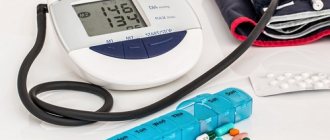Types of diabetes
Doctors distinguish two main types of diabetes.
Type 1 diabetes
is insulin-dependent diabetes mellitus (IDDM). The disease is associated with dysfunction of the pancreas. It is the pancreas that produces insulin. With significant (more than 90%) destruction of the cells responsible for its production, the amount of insulin in the blood drops and carbohydrate metabolism is disrupted. Glucose, still entering the blood, cannot be absorbed by the body. In this case, muscle tissue cells experience glucose deficiency. As a result, a person with type 1 diabetes loses weight quite quickly. Type 1 diabetes occurs more often in people under 30 years of age.
Type 2 diabetes
– non-insulin dependent diabetes mellitus (NIDDM). This type of disease is caused by tissue loss of sensitivity to insulin. In type 2 diabetes, the insulin level in the blood can be anything - normal, low or high. But the cells stop responding to it and the concentration of glucose in the blood increases. As a rule, the disease develops against the background of obesity. Type 2 diabetes most often affects people over 30 years of age.
There are other, less common types of diabetes.
How to stop eating junk food?
It’s worth saying right away that it’s almost impossible to completely give up sweets, fried foods, fatty foods, and high-carbohydrate foods, and only 10% of people who previously didn’t particularly like such foods can do it. That is why you are allowed to eat your favorite unhealthy food once a week. As for nutrition on other days, you will have to try to remove excess foods from your diet. The most important rule is not to buy prohibited products and not to store them at home. There are also other recommendations:
- Low-calorie foods come first. You need to start each meal with foods that contain fewer calories. Non-starchy vegetables provide the perfect low-calorie base and energy boost. They also suppress hunger.
- Instead of salads - individual products. If you don't mix the vegetables with the dressing, you can simply cut them into pieces and eat. As practice shows, a much smaller amount of food is eaten, while the feeling of satiety increases.
- Making handmade products. Before you lose weight with type 2 diabetes, you will have to try many hobbies. To take your mind off food, you can knit, sew, do crossword puzzles, or even play a computer game. The most important thing is that you should enjoy the activity and captivate it so that you can’t even think about food.
- Regular teeth cleaning. Mint flavored toothpaste suppresses appetite. If you really want to eat at the wrong time, you can immediately go brush your teeth.
On the subject: What does fractional nutrition mean?
The most popular diets for weight loss with diabetes
If you have diabetes, you should focus on consuming proteins and fiber, pay attention to simple carbohydrates of natural origin (fruits and vegetables), start consuming low-fat milk, yoghurts, cottage cheese and other dairy products, add various vegetable oils, nuts, and avocados to your diet. The most common diets are:
- Food restrictions. For people with diabetes, there are certain foods that should be limited. These foods may raise your blood sugar or contain unhealthy fats. The diet reduces or eliminates processed grains (rice, etc.), canned or sweetened fruits, full-fat dairy products, fried foods, complex carbohydrates, sweets, etc.
- Mediterranean diet. This diet is rich in fatty acids, which have a beneficial effect on the health of the body. This type of nutrition can be successfully used to lower glucose levels, reduce body weight and reduce the risk of metabolic disorders. The basis of the diet is poultry, salmon, tuna and other types of fatty fish, eggs, vegetables, fruits, vegetable oils, and small quantities of nuts (mainly almonds). In some cases, complex carbohydrates or red meat are allowed. As for strong alcohol, you should completely avoid it. The optimal solution would be a glass of red wine, which has a beneficial effect on the heart.
Natural diet. It is based on the belief that modern agriculture is to blame for all chronic diseases. Followers of the diet eat only those foods that ancient ancestors, since the dawn of civilization, could have collected with their own hands or obtained while hunting or fishing. That is why the menu contains only meat, fish and poultry, vegetable fats, fruits and vegetables, nuts, berries, herbs and spices obtained naturally. Of course, sometimes only flower honey is used for sweets. A natural diet may be a good option for people with diabetes, as long as the person does not have kidney disease. To this list you can also add avoidance of gluten, which is the protein of some grains. Another common diet is vegetarianism (refusal of meat, fish and other products that previously had a nervous system), as well as veganism (refusal not only of meat and fish, but also of eggs, dairy products and any food of animal origin). All presented options are standard; the diet can be adjusted depending on the individual characteristics of the person. It's important to continue eating healthy and exercising regularly even after you reach your weight loss goal. Healthy weight management habits should last a lifetime. Only if you really want to change your body and improve your health can you achieve excellent results and maintain them for a long time without extreme effort.
Related posts:
The benefits of losing weight - 15 health benefits
Abdominal obesity
How to lose weight after 50 years
Real stories of losing 20 kg with photos and videos before and after!
Why protein diets don't work either
Test check yourself:
fact or fiction?
Eating more fruit can improve bone density.
Correct! Wrong!
Consuming foods with plenty of bioavailable calcium improves bone density. Fruits generally do not contain much calcium.
Excess protein accumulates in the muscles, causing them to increase.
Correct! Wrong!
Once the need for protein and energy has been met, excess amino acids are converted to acetyl-CoA, from which they are converted into fatty acids and stored in adipocytes. Therefore, excess protein will not be converted into muscle.
Complications of diabetes
Diabetes mellitus leads to decreased immunity. As a result, the patient more often suffers from various diseases, the recovery process is delayed, and the diseases often become chronic. The healing of various wounds (cuts, abrasions) is worse. Nervous tissue and blood vessels suffer. The development of atherosclerosis is stimulated, the vessels of the eyes and kidneys are affected, and the blood supply to the skin is disrupted. The combination of disorders of various systems leads to a complex of complications called diabetic foot syndrome. The foot, due to its peripheral position, turns out to be the most vulnerable - pathological changes caused by diabetes can lead here to inflammatory processes, ulcers, and tissue necrosis. In advanced cases, amputation may be required.
ketoacidosis , are dangerous
– accumulation of products of intermediate metabolism of fats (acetone) in the blood. Ketoacidosis is characteristic of type 1 diabetes.
Causes of diabetes
Among the factors contributing to the occurrence of type 1 diabetes mellitus
, usually distinguished:
- heredity. When type 1 diabetes is diagnosed in both parents, the probability of the disease is 30%;
- viral infections that cause damage to the pancreas (rubella, mumps, chicken pox, hepatitis, etc.);
- autoimmune diseases.
The main factors that increase the risk of developing type 2 diabetes mellitus
, are:
- heredity. The influence of this factor in type 2 diabetes is higher than in type 1 diabetes. If one of the parents has type 2 diabetes, the probability of developing the disease is more than 40%;
- obesity, overweight;
- impaired glucose tolerance (this condition is called prediabetes
). With prediabetes, elevated blood glucose levels are recorded, while other symptoms of diabetes are absent; - age. With age, the likelihood of developing the disease increases;
- cardiovascular diseases.
Background
At the age of 30, I was diagnosed with type 1 diabetes. Shock, panic, rejection of what was heard - everything was over, but the disease did not go away from emotional experiences, only getting worse. I had to pull myself together and start living from scratch. All my life I played sports, played basketball, swam, ran short and long distances. I have always been a fit, slender person; with a height of 183 cm, I weighed 73-75 kg. Until the very end, he argued with the doctors; he did not want to give insulin injections, because he knew about the sharp increase in weight of each patient after taking the drug. The troubles could not be avoided; in 1 month I gained 18 kg. Abs were a thing of the past; I could no longer climb to the 5th floor without shortness of breath; the reflection in the mirror brought only negative emotions. My therapist, Viktor Stepanovich, quickly sensed my depressive mood and said that it was possible, but difficult, to return the body to its former beauty. Athletes are not afraid of difficulties, it was decided to lose weight. Working together with Viktor Stepanovich and his endocrinologist friend (unfortunately, I don’t remember his name) was difficult, but in the end we outlined several different options.
Symptoms of diabetes
The main symptoms of type 1 and type 2 diabetes are the same, but each type of disease has its own specifics.
The complex of main symptoms is caused by elevated levels of glucose in the blood. However, if in type 1 diabetes these symptoms are immediately noticeable, then type 2 diabetes may initially proceed for a long time without obvious symptoms.
Increased urine output
With a long-term concentration level above 6 mmol/l, glucose begins to penetrate into the urine. If the disease develops and the patient's condition worsens, the concentration of glucose in the urine increases. To lower it, the kidneys begin to secrete more water. As a result, the amount of urine excreted per day increases. This condition is called polyuria
.
Thirst
Because the body loses a large amount of water, the patient experiences constant thirst (polydipsia). The amount of fluid consumed increases. Lack of water in the body also manifests itself through dry skin and a feeling of dry mouth.
Increased appetite
For type 1 diabetes, a typical symptom is polyphagia - increased appetite or even a constant feeling of hunger.
Weight loss
Despite an increased appetite, a person with type 1 diabetes loses weight quickly.
Increased fatigue
Patients with diabetes are characterized by weakness (increased fatigue).
Deterioration of vision
The development of diabetes mellitus leads to visual impairment.
More about the symptom
Itching of the genitals
Diabetes mellitus can cause itching of the genitals.
Furunculosis
Diabetes mellitus leads to the development of inflammatory skin lesions and furunculosis (the appearance of boils).
Methods for diagnosing diabetes mellitus
If you suspect diabetes, you should definitely consult an endocrinologist. JSC “Family Doctor” offers to use the laboratory profile “Assessing the risk of developing diabetes mellitus,” which includes all the necessary tests. Based on the data obtained, the doctor will be able to assess the condition of your body and give the necessary recommendations.
Diabetes is diagnosed based on laboratory tests, primarily assessing blood glucose levels.
Measuring blood sugar levels
Nowadays, it is easy to purchase a glucometer for home use. Having such a device, patients with diabetes can quickly monitor their blood sugar levels. To do this, measurements should be taken in the morning on an empty stomach, and also 2 hours after eating. The second analysis will assess how well the body copes with the absorption of food.
Analysis for glycated hemoglobin
Glycohemoglobin (glycated hemoglobin) is a biochemical indicator that allows you to assess the degree of binding of hemoglobin with sugar molecules. This analysis is used both to diagnose diabetes and to monitor the progress of treatment (the patient’s condition). Those who have been diagnosed with diabetes should undergo this diagnosis once every three months. For those who are at risk of developing the disease - once every six months.
Blood chemistry
A biochemical blood test allows you to assess the level of glucose in the blood. Other indicators that make it possible to draw conclusions about the state of metabolic processes in the body are also important.
More information about the diagnostic method
Blood test for C-peptide
A blood test for C-peptide is a hormone test. This test allows you to estimate how much insulin is produced inside the body.
General blood analysis
A general blood test makes it possible to assess the general condition of the body. In particular, an increased hemoglobin value may indicate dehydration, while a decreased value may indicate internal bleeding. the likelihood of which increases with diabetes.
More information about the diagnostic method
Sign up for diagnostics To accurately diagnose the disease, make an appointment with specialists from the Family Doctor network.
Methods for treating diabetes mellitus
Today, diabetes mellitus is no longer a disease in which it is impossible to live normally, work, play sports, etc. Modern medicine has the necessary tools to make the life of a person with diabetes mellitus no different from the life of healthy people. However, for this it is necessary to identify the disease in a timely manner, constantly monitor blood sugar levels and follow all the doctor’s prescriptions.
Treatment for diabetes mellitus is aimed at achieving compensation. Compensation for diabetes mellitus is maintaining blood glucose levels within the normal range. This condition allows you to normalize hydrocarbon metabolism, as well as improve fat, protein and water-salt metabolism.
Treatment of diabetes mellitus is complex and includes a special diet, the use of medications, and physical activity in the required amount.
Specialist consultation
It is important to teach the patient to independently monitor his condition and control his behavior. For people suffering from diabetes, endocrinologists at the “Family Doctor” conduct special classes “School for Diabetes Patients”, where doctors talk about the disease, the characteristics of the diabetic diet and the regime of necessary physical activity.
Make an appointment Do not self-medicate. Contact our specialists who will correctly diagnose and prescribe treatment.
Rate how useful the material was
thank you for rating
Basic Rules for Weight Loss with Type 1 Diabetes
- Everything has its time. Many people think that losing it all can be as easy as gaining it. In fact, it is difficult even for a healthy person to do this. You need to be patient, keep a food diary and follow all the instructions and points planned in advance. You also need to be prepared for the fact that your diet will completely change.
- Insulin control. As mentioned above, in type 1 diabetes, insulin is not produced by the pancreas at all, so it is supplied to the blood artificially. At the same time, this hormone directly affects the metabolic system and can cause serious weight problems. Therefore, you need to keep a record of what dose was administered and when the next injection is due. The optimal dose is calculated by the doctor individually for each person.
- Golden mean. There is no need to strive to lose all unnecessary kilograms in just a few days. The optimal figure is no more than 1 kg per week (in the first stages - no more than 2 kg). Acute food stress can negatively affect the health of the body and its general condition, as well as significantly increase the rate of insulin consumption.
Find out the causes of excess weight and ways to quickly lose weight
Sign up for a free initial appointment with a nutritionist!
As you can see, everything depends on the amount of insulin. But everyone has their own norm, and some will need 100 units of medication per day, while others will need 50. Therefore, there are simple ways to reduce insulin levels, taking into account the regular consumption of fats and carbohydrates:
- Reduce carbohydrate intake;
- Reduce protein intake;
- Increase physical activity;
- Reduce the number of snacks.
Of these, reducing your carbohydrate intake will have the greatest effect. Insulin doses should be reduced only if adjustments are allowed by your doctor. You will have to meet with a doctor in any case, since any change in diet requires a revision of the dosage of medications taken. Some people may struggle to lose weight on a low-carb diet if their diet is high in protein. Therefore, you will have to replace some of the meat, eggs and dairy products with foods of plant origin. Walking after meals is a good way to lower your sugar levels. Getting into the habit of regular exercise should help reduce your insulin consumption. Regular yoga and swimming also help.
Steps to Weight Loss Success for People with Type 2 Diabetes
Research shows that the longer a person has a high body mass index, or BMI (a common measure of overweight or obesity), the higher the risk of developing type 2 diabetes. Having excess body fat increases the body's resistance to insulin, making it more difficult to manage blood glucose levels. According to the World Health Organization, 90% of people with type 2 diabetes are overweight or obese. Scientists also believe that it is weight problems that lead to metabolic disorders and diabetes. It's no secret that losing weight is not easy, and in general, is it possible to lose weight with diabetes. And if the process itself is further complicated by the fact that the cells do not perceive insulin and dislocate all the glucose in the blood, then you will have to draw up an action plan in advance and follow each point in order to achieve a positive result.
Dietary Control: On the Path to Success
- Exercise stress. Exercise can help you lose weight. Research shows that people who increase physical activity while reducing their calorie intake will lose more fat than people who only diet. At the same time, you can choose completely different sports, ranging from shaping, yoga and aerobics, to race walking, athletics, etc. It will also not be superfluous to sign up with a trainer to draw up an individual training schedule, thanks to which the optimal number and duration of various exercises will be selected.
- Not a day without breakfast. The most effective diabetic diet includes breakfast. Skipping breakfast can lead to overeating. This can disrupt your weight loss plans and cause your blood sugar levels to rise. Research shows that eating breakfast, especially grains, is associated with better weight loss. Specialty cereals do not contain sugar and are high in fiber. Combining cereal with a high-protein food (such as milk) may help control blood sugar. But here's how to quickly lose weight with type 2 diabetes without sugar at all - such an effective diet does not yet exist.
- Reducing calories. The exact number of calories people on a diabetic diet should consume depends on a number of factors, including age, gender, current weight, activity level and body type. The optimal range for people with type 2 diabetes is 1,200 to 1,800 calories per day for women, and 1,400 to 2,000 calories per day for men.
- Friendship with fiber. High amounts of fiber help lower blood sugar levels and speed up weight loss. Research shows that higher fiber intake can prevent weight gain. It is recommended that women consume at least 25 grams of fiber daily, while men consume about 31 grams. For starters, you can add fiber-rich legumes, such as chickpeas and black beans, to your first meals. They can also be used as a side dish. But it is worth remembering that in large quantities they can lead to inhibition of the process of food absorption and discomfort in the gastrointestinal tract.
- Small portions are the best solution. A diabetic diet that consists of three or more small meals a day is better than a diet that includes only one or two large meals. Eating large meals can cause your blood sugar levels to rise, while eating smaller meals more frequently will help lower your post-meal glucose levels. Additionally, a diabetic diet consisting of mini-meals spread throughout the day will help control hunger and calorie intake, which can lead to faster weight loss.
- Gradual movement towards the goal. You cannot expect the maximum effect right away, as this may negatively affect your psychological attitude towards the process. Instead, you should set small, realistic goals, such as having dessert once a week, walking to work several times instead of taking public transportation, not drinking alcohol, etc. Once these goals become habits, you can move on to the next goal. There is a sense of accomplishment while moving towards your ultimate weight loss goal.
- Ongoing support. Staying motivated and sticking to a weight loss plan can be difficult when doing it alone. Talking to other people and getting advice on how to lose weight with diabetes can provide the emotional support you need to stay on track. For some people, support not only from family and friends, but also from people on social networks with the same problems can be as effective as regular face-to-face communication. The most important thing is to find like-minded people who are not afraid to share their achievements and failures, problems and solutions, questions and answers.
Of course, all this cannot be done without the so-called food diary. It helps not only with diabetes, but also with any other necessary dietary changes. It is with the help of a kind of planner that you can control the consumption of sugar and carbohydrates, the number of calories consumed and burned, and the water that was drunk throughout the day. Day after day, filling out the appropriate columns and tables, you can develop a lasting habit. In addition, a food diary can be used to record your emotions and changes in the body, and other information that will directly relate to how to lose weight with type 2 diabetes.











